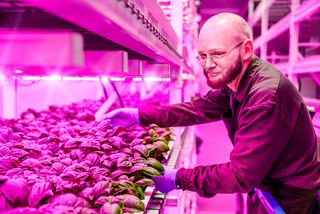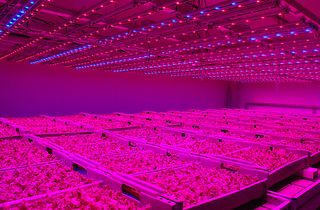
New Tech Sheds Light on the Future of Food

This article was originally published at The Conversation. The publication contributed the article to Live Science's Expert Voices: Op-Ed & Insights.
The challenges of growing enough food to feed the world have grown more severe in the 21st century. We need to feed more people with limited agricultural land and resources. We need to make better use of land, light and logistics for an increasingly urban population. And we need to incorporate zero-waste and low-energy technologies into the task of food production. What can achieve the intensification of food supply we require, but in a way that is also sustainable and less harmful to the environment?
There is an urgent need to develop new methods for sustainable food production. This includes a greater emphasis on urban agriculture such as vertical farming which, properly designed and planned, could provide the sustainable means to improve food supply we need. Ideally, urban agriculture fits neatly alongside or within existing buildings in a self-contained and sustainable manner without competing for resources. Such urban plots can be at ground level or on rooftops. They can use greenhouses in order to take advantage of the sun’s energy, or grow indoors with the help of artificial lights.
Vertical Farming is promising because it requires no soil, and can save space and energy – and improve crop yield. It takes advantage of the vertical space of city buildings rather than turning over wide expanses of land to agriculture and uses advanced greenhouse technology: hydroponics or aeroponics, and environmental controls that regulate temperature, humidity and light to produce vegetables, fruits and other crops year-round.
In large cities such as New York, Chicago, Tokyo and Singapore, these ideas are taking root. Singapore has taken local urban farming to a high level – Skygreens has built the world’s first commercial vertical farm in large three-storey greenhouses, providing a sustainable source of fresh vegetables.
The cost of growing
Vertical farming’s biggest limitation is energy consumption. Considerable energy is required to power a closed, indoor greenhouse facility’s artificial lighting, heating and cooling, and hydroponic or aeroponic growing systems. The amount of energy required per unit of product is an important factor for ensuring not only that the farm is sustainable, but that it is economically viable. Recently, more and more studies have focused on pairing solar panels and wind turbines with greenhouses to provide self-generated renewable electricity on-site.
But the single technology that will be key to making vertical farms possible is lighting. New LED light technology is the key that makes it possible to build vertically integrated farms. This kind of artificial light has an extremely high photoelectric conversion efficiency, consuming only one eighth the power of incandescent lamp, half of the power of fluorescent lamp, and using a lower supply voltage (6-24V) that makes it safer to work with and reduces transmission losses.
Sign up for the Live Science daily newsletter now
Get the world’s most fascinating discoveries delivered straight to your inbox.

They’re also physically small, have a long service life, lower power consumption, generate less heat, and can produce light of varying intensity. Because it produces less heat, the light can be moved closer to the plants. This increases efficiency, not just in terms of energy use but by allowing layers of growing plants to be more densely packed, making more efficient use of space.
LED lights can be tuned to emit only a narrow wavelength of light, they can be combined to create perfect lighting that provide light on the ideal spectrum for a plant’s growth. Evidence is emerging that specific wavelengths of light have distinct effects on crop yield, quality, and even pest and disease resistance.
There is potential for these multifunctional techno-greenhouses built around LED grow lights to increase the quality of the food we eat and the amount that we can grow with the same land and resources: the very 21st-century problems we now face – and through technology are getting closer to solving.
Chungui Lu receives funding from the UK Technology Strategy Board to work on developing LED lighting for horticultural crops.
Erik Murchie receives funding from the UK Technology Strategy Board to work on developing LED lighting for horticultural crops.
This article was originally published on The Conversation. Read the original article. Follow all of the Expert Voices issues and debates — and become part of the discussion — on Facebook, Twitter and Google +. The views expressed are those of the author and do not necessarily reflect the views of the publisher. This version of the article was originally published on Live Science.
